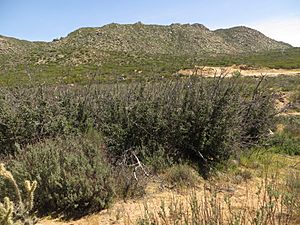Palmer oak facts for kids
Quick facts for kids Palmer oak |
|
|---|---|
 |
|
| Conservation status | |
| Scientific classification | |
| Genus: |
Quercus
|
| Species: |
palmeri
|
 |
|
| Natural range of Quercus palmeri | |
| Synonyms | |
|
|
Quercus palmeri is a special kind of oak tree. It's often called the Palmer oak or Palmer's oak. You can find it growing in dry places. These include California, Baja California, New Mexico, and Arizona. It likes canyons, mountain slopes, and dry riverbeds. Another name for it is Dunn oak.
Contents
Discovering the Palmer Oak
What Does the Palmer Oak Look Like?
The Palmer oak is usually a shrub or a small tree. It can grow up to 3 meters (about 10 feet) tall. Sometimes, it can even reach 6 meters (about 20 feet)! Its branches are reddish-brown. They have a slightly angular shape.
The leaves of the Palmer oak are small. They are usually 1 to 3 centimeters (0.4 to 1.2 inches) long. They feel stiff, leathery, and brittle. Their edges are wavy and have sharp, spine-like teeth. The top side of the leaf is shiny and olive green. The underside is gray-green. It is covered with tiny, sticky hairs.
The fruit of the Palmer oak is an acorn. The acorn has a hairy cap. This cap can be up to 2.5 centimeters (about 1 inch) wide. The nut part of the acorn is 2 to 3 centimeters (0.8 to 1.2 inches) long. It has a blunt end.
An Ancient Survivor: The Jurupa Oak
Palmer oaks often grow in small groups. What's super cool is that some of these groups are actually clones! This means they are all part of one single plant. Imagine a plant that keeps sending out new shoots. All these shoots are genetically identical to the original plant.
One amazing example is the Jurupa Oak. It is found in the Jurupa Mountains in Riverside County, California. Scientists have studied this particular Palmer oak clone. They found out it is over 13,000 years old! This makes it one of the oldest living plants in the world. It's like a living fossil from the Pleistocene ice age. This single plant has been alive for thousands of years. It has survived by growing new stems from its roots.
See also
 In Spanish: Quercus palmeri para niños
In Spanish: Quercus palmeri para niños



